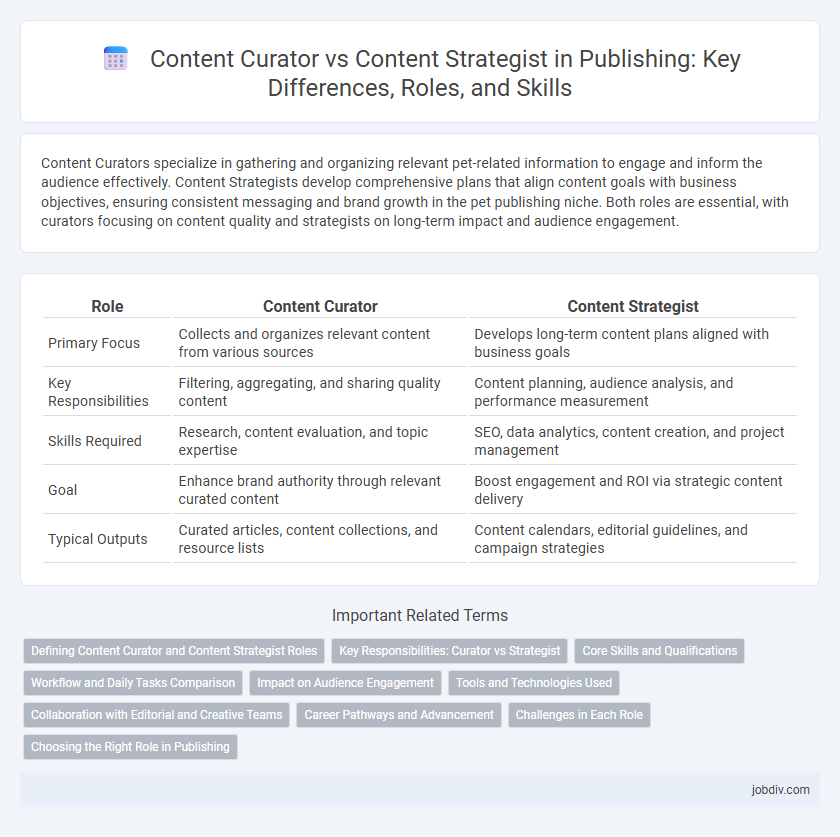Content Curators specialize in gathering and organizing relevant pet-related information to engage and inform the audience effectively. Content Strategists develop comprehensive plans that align content goals with business objectives, ensuring consistent messaging and brand growth in the pet publishing niche. Both roles are essential, with curators focusing on content quality and strategists on long-term impact and audience engagement.
Table of Comparison
| Role | Content Curator | Content Strategist |
|---|---|---|
| Primary Focus | Collects and organizes relevant content from various sources | Develops long-term content plans aligned with business goals |
| Key Responsibilities | Filtering, aggregating, and sharing quality content | Content planning, audience analysis, and performance measurement |
| Skills Required | Research, content evaluation, and topic expertise | SEO, data analytics, content creation, and project management |
| Goal | Enhance brand authority through relevant curated content | Boost engagement and ROI via strategic content delivery |
| Typical Outputs | Curated articles, content collections, and resource lists | Content calendars, editorial guidelines, and campaign strategies |
Defining Content Curator and Content Strategist Roles
A Content Curator specializes in sourcing, organizing, and sharing relevant content to engage target audiences and maintain a consistent brand presence. A Content Strategist develops overarching plans that define content goals, audience personas, and distribution channels to optimize brand messaging and drive business growth. Both roles collaborate to ensure content alignment with marketing objectives, but the strategist focuses on planning while the curator emphasizes content selection and presentation.
Key Responsibilities: Curator vs Strategist
Content curators focus on aggregating, organizing, and presenting relevant information from various sources to create cohesive collections that engage target audiences. Content strategists develop comprehensive plans that define content goals, audience personas, distribution channels, and performance metrics to align content with business objectives. While curators prioritize content selection and thematic curation, strategists emphasize planning, execution, and measurement of content impact across platforms.
Core Skills and Qualifications
Content Curators excel in research, filtering, and organizing relevant information, ensuring audience engagement through timely and accurate content selection. Content Strategists possess strong skills in market analysis, SEO, and content planning, driving brand messaging and long-term growth objectives with data-driven insights. Both roles require proficiency in digital tools and a deep understanding of audience behavior to maximize content impact.
Workflow and Daily Tasks Comparison
Content Curators focus on sourcing, organizing, and sharing relevant information from various platforms to maintain audience engagement, often using digital tools for efficient content aggregation. Content Strategists develop comprehensive plans aligning content with business goals, involving keyword research, audience analysis, and performance tracking to optimize content impact. Workflow differences highlight that curators prioritize content discovery and curation schedules, while strategists emphasize long-term planning, editorial calendars, and cross-department collaboration for cohesive brand messaging.
Impact on Audience Engagement
Content curators enhance audience engagement by selectively gathering and organizing relevant materials, ensuring timely and diverse content that meets audience interests. Content strategists drive deeper engagement through comprehensive planning, audience analysis, and content creation aligned with brand goals and user needs. Both roles are crucial, but strategists typically have a broader impact on long-term audience retention and meaningful interactions.
Tools and Technologies Used
Content curators primarily utilize tools such as Feedly, Pocket, and BuzzSumo to gather, organize, and share relevant content efficiently. Content strategists depend on platforms like Google Analytics, SEMrush, and Trello to analyze audience behavior, plan editorial calendars, and optimize content performance. Both roles leverage CMS systems like WordPress, but content strategists integrate SEO tools and data analytics more extensively to drive content decisions.
Collaboration with Editorial and Creative Teams
Content curators collaborate closely with editorial teams to select and organize relevant materials that enhance publication themes, ensuring cohesive storytelling. Content strategists work alongside creative teams to develop comprehensive plans that align content goals with audience engagement and brand objectives. Both roles integrate efforts to optimize content delivery and maintain consistent messaging across all publishing platforms.
Career Pathways and Advancement
Content Curators specialize in sourcing and organizing relevant information to engage target audiences, often starting in entry-level roles like research assistants or social media coordinators and advancing to senior curation or editorial positions. Content Strategists develop comprehensive content plans aligned with business goals, requiring skills in analytics and project management, with career progression leading to roles such as content marketing manager, UX content strategist, or chief content officer. Both pathways offer growth opportunities in digital marketing and media, with strategists typically commanding higher leadership responsibilities and broader influence over brand messaging.
Challenges in Each Role
Content Curators face challenges in filtering vast amounts of information to maintain relevance and accuracy while ensuring timely updates that engage the target audience. Content Strategists struggle with aligning content goals to broader business objectives, managing cross-functional teams, and measuring content effectiveness through key performance indicators (KPIs). Both roles require adaptability to evolving digital trends and audience preferences to drive sustained content success.
Choosing the Right Role in Publishing
Content Curators specialize in gathering, organizing, and presenting relevant information to engage specific audiences, ensuring timely and accurate content delivery. Content Strategists develop comprehensive plans to create, manage, and optimize content across multiple platforms, aligning editorial goals with business objectives. Choosing the right role in publishing depends on whether the priority lies in effective content aggregation or in driving long-term strategic content development.
Content Curator vs Content Strategist Infographic

 jobdiv.com
jobdiv.com